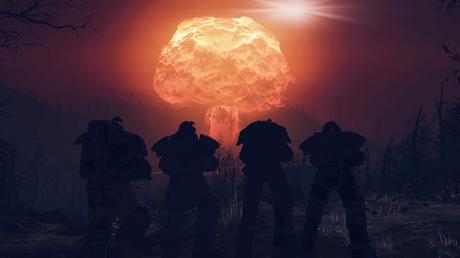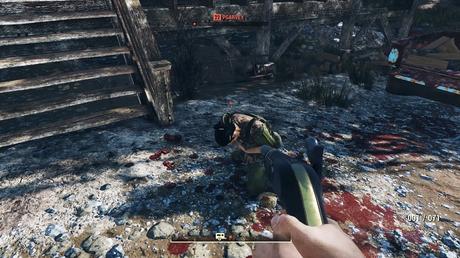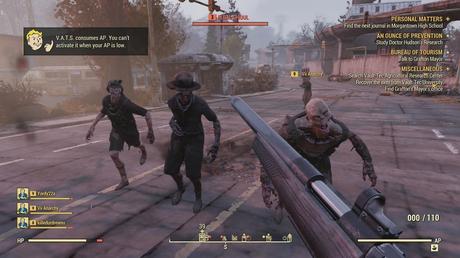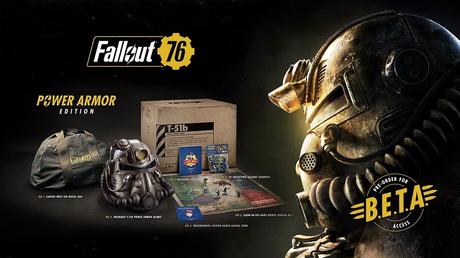Bethesda was once the king of video game publishers in the department of releasing buggy, half-broken games that its core audience accepted with open arms and a sense of determination that they could be fixed and enjoyed regardless. With the release of Fallout 76, the aging cracks in their facade of good intentions are showing worse than ever.
 Image credit: Wccftech.com
Image credit: Wccftech.com
It would be disingenuous to say the newest Fallout is anywhere near the worst game of all time, but it very well may be Bethesda’s worst release since their licensed Home Alone title for the NES back in 1990. Weeks of complaints have done little to fix its crashes, graphical bugs, generally unsatisfying core gameplay loop and easily exploited engine. The only use it has as an entertainment product is one of unintentional schadenfreude to those with an interest in watching a publishing company evolve into an accounting-oriented disappointment factory.
West Virginia, the Great War, and you
For better or worse, Fallout 76 feels like Bethesda wanted to test the waters with rebooting the lore of the series without completely trashing what already exists. Set 25 years after the lore-important Great War that led to the titular nuclear fallout to blame for this entry in the series, 76 puts the player in the shoes of an inhabitant of Vault 76, built to shelter the greatest minds of America from impending nuclear doom. Just a few short decades later the doors to the outside world open and the survivors are set loose on the war-torn wasteland to try and rebuild a better future for those who suffered through the horrors of thermonuclear war.
To further distance itself from its sister entries, you’ll find no human NPCs in the world to interact with. While this makes sense at a glance—the player character is supposed to be one of the first survivors stepping back into the world to rebuild it—this kind of setup begins to fall apart as you actually explore the world. The landmarks of West Virginia and its map are sprawling, fairly well-crafted and contain enough points of interest to keep players poking around to find what may be hiding around the next corner yet lack the basic logical consistency that allows for any level of narrative immersion.

Following the main quest takes the player character on a journey to battle the Scorched, a race of zombie-like enemies created through means not worth spoiling in a review. Their design seems to revolve around implementing enemies with vaguely human behavior including the intelligence to use guns without resorting to using bandits as the game’s most plentiful antagonists. Every aspect of the main quest, as well as most of the side quests, winds up delivered into your hands through audio and text logs left by survivors both recently deceased and long since dead, which adds further questions to the pile of logical inconsistencies.
While not on the main quest you’re free to construct a base through the deployment of your Construction and Assembly Mobile Platform, colloquially known as the C.A.M.P. Building strangely shaped houses, placing turrets to defend your stead and install storage for squirrelling away gear to your heart’s content make up the main draw of this side endeavour that runs into late game problems outside of the appeal of free-form base creation. You’ll eventually resort to hoarding and scrapping supplies wildly to no real end beyond the thrill of the build and how much that appeals to you is a hit-or-miss proposition.
76 attempts to live up to its RPG roots through a revamped attributes and perks system known as S.P.E.C.I.A.L. Players assign points to stats like strength and intelligence which then determine which skills are available to them, as to be expected, but with a twist in the form of randomised cards being made available with each level. Cards can then be unequipped and changed out on the fly, which does allow for more flexibility than earlier titles allowed.
Player interactions were meant to be made more special via the lack of NPCs. Every person you see running around the world in oddly-painted power armor or Civil War garb is another player with whom you may befriend or fight at a moment’s notice. The game’s looting loops feel co-op oriented but there is the option for PvP combat, albeit without much risk of losing or gaining anything substantial beyond ammunition. Fighting is low risk and low reward outside of currency rewards for taking down wanted players for bounties.
Once you peel away the boilerplate appeal, the deeper flaws begin to pop up at an alarming rate.
Finding the positive in a poor foundation

Listing the positives that make Fallout 76 worth playing is both the easiest and shortest part of any critical analysis in the most disappointing way possible. The core of its engine seems to be built on a foundation that could be polished into something enjoyable given another six months of development time, assuming Bethesda remembers how to fix bugs of their own creation any more. Fallout 76 runs on a modified version of the Fallout 4 engine with minor graphical upgrades to bring it up to the standards of 2018 while also suffering from model and texture bugs that take it right back to the early 2000s of broken and bizarre 3D models.
In fact, most portions of the game that attempt to build on what Fallout 4 put into place make up the highlights of the game, by and large. Most of the praise lavished on 4 revolve around the joy of exploring and how the series’ gunplay finally reached an acceptable level of fun to engage in.
Exploration still has its appeal, but the system that handled combat suddenly has a layer of latency and uncertainty on top of its natural clunkiness that is hard to shake off. Hit registration is client-side and thus occasionally unruly, enemies are likely to clip through solid objects or distort wildly after death and the inclusion of the time-honoured V.A.T.S. system has been reduced to an auto-aim button that removes the need to actually strategise or even play the game.
Almost every other aspect of the game seems to have worsened from its predecessor. Our initial report on the game’s announcement was much more optimistic and for a generally good reason: Bethesda seemed to be responding to its players and their want for a multiplayer experience. Everything that followed was just an accident waiting to happen.
A buggy, unstable mess

The most readily apparent issue with Fallout 76 is the sheer number of bugs present. At first, it was an amusing visual bug that squashed the player’s character model after leaving power armor as if it were still inside, showing off just how poorly the current design would work in real life. Then came the usual suite of issues that come with the constant re-use of the Creation engine in its various forms: Players falling through the world, models stretching unnaturally, unintentional clipping through objects and weather events seeping out of the ground.
Then there were networking problems and disconnects that lead to minutes of lost progress, thanks to the game’s lack of manual saves like its previous entries. If you press towards the endgame and happen to take part in launching nukes, a natural step towards endgame grinding, too many simultaneous launches can cause server crashes. If you’re really unlucky, players in your server can outright cheat with reckless abandon. Some of these issues have been patched yet it’s not uncommon to see new methods of sidestepping the encumbrance limit crop up from time to time.
For a time it was even possible for users to see the IPs of connected players and potentially force their clients to disconnect, but reports on that bug still persisting are wild and varied. Dealing with this many issues on top of the game being somewhat unstable shows a deep misunderstanding of handling online game development rather than single-player experiences, which was an early concern for those familiar with Bethesda’s publishing history.
The only possible upside to this whole mess is becoming an unkillable god from which there is no escape, which doesn’t exactly jive with traditional Fallout lore.
A lore snafu in the works

If you came for an enthralling story, prepare to leave disappointed. When you’re not wedged between pieces of the scenery and trying desperately to escape you’ll be listening to multi-minute audio recordings of the recently deceased dumping exposition at you as if their ex-lives depended on it. This removes a large core component of questing and storytelling in the realm of player agency and choice. Fallout 4 saw its fair share of criticism for boiling its RPG elements down to a set of four choices with excessive duplication of available answers.
Taking away roleplaying choices entirely just makes 4 more appealing by comparison for all the wrong reasons. Worse yet, single-player games at least have the courtesy to pause or delay critical plot messages that are occasionally overridden without warning in 76 in a way that can make its bland attempt at storytelling frustrating to follow. Playing a multiplayer game that includes voice chat doesn’t pair well with exposition tapes that last for five minutes at a time unless you play with incredibly patient friends.
Furthermore, you’re expected to believe that players alone are the only characters to survive in the wasteland. Between the Scorched, the murderous robots and wildly mutated Virginia wildlife there are some points that make sense in having fewer NPCs than before. It’s only 25 years after the Great War and camps should feel rare, but having such an obviously lazy choice of design makes the immersion problem more difficult to swallow.
The recurring issue of Bethesda’s public relations
Launching a new online-only game at the same time as a games platform was almost certainly doomed to fail for a company with little to no experience handling networking services as a whole. With console patches around 47 gigabytes in size and beta issues that included an accidental deletion and re-download of the client for some users, things were only starting to take a turn for the worse.

Those who pre-ordered the game’s most expensive package experienced the wonders of false advertising firsthand in the form of a nylon bag of poor quality rather than the promised canvas version. Naturally, Bethesda sent media influencers canvas versions of the bag to further entice buys which was met with appropriate outrage. After a half-hearted apology, they proceeded to accidentally leak personal information of those requesting replacement bags promised by the company. Again, this was met with an apology and little else.
During this minor fiasco, they promised more transparency with the game’s ongoing development and its patching process which they followed up with undocumented nerfs to game progress and several new and exciting bugs in their usual fashion.
Despite all of these ongoing issues they’ve seen fit to release a cosmetic Christmas pack that costs nearly a third of the title’s asking price that pales in comparison to the much cheaper community Christmas mod pack released for Fallout 4 at a fraction of the price.
The ultimate sin
Many of these smaller issues could be swept away if Fallout 76 were fun. Unfortunately, it just isn’t. It is a slow and uncomfortably fiddly mess that takes all the potential fun of stomping around in the Fallout universe with your friends and manages to suck most of the enjoyable elements of the series out in the process. It’s a buggy and broken testament to just how unready Bethesda was to release an online game. If it has any value to be had outside of its unintentionally hilarious bugs, it may serve as a wake-up call to the gaming community regarding the folly of pre-orders and propping developers up on pedestals as they become distanced from the people who made their games a success in the first place.
Though it bears the Fallout name, this game is an empty shell that Bethesda has rolled out well before it was ready. It hinges on being a product produced as quickly as possible for maximum financial returns and it is distinctly insulting in its blatant mishandling. Series newcomers and long-term fans alike should give this game a complete miss.

